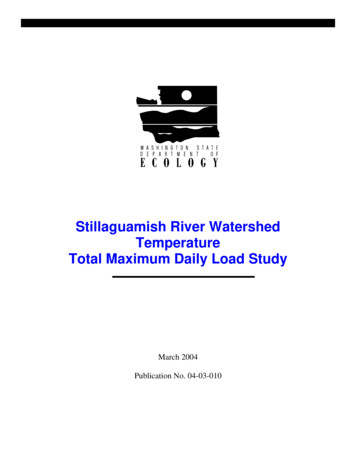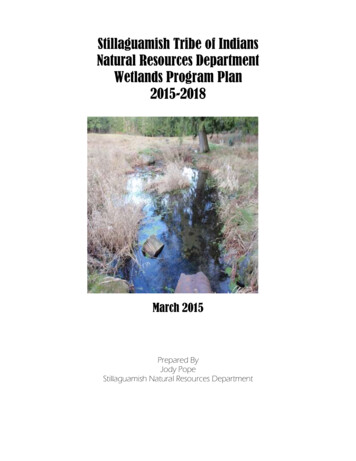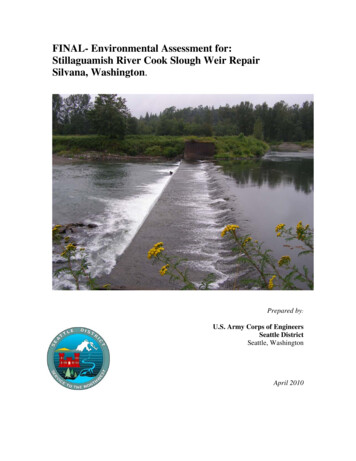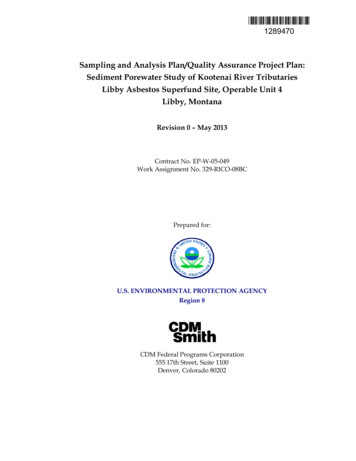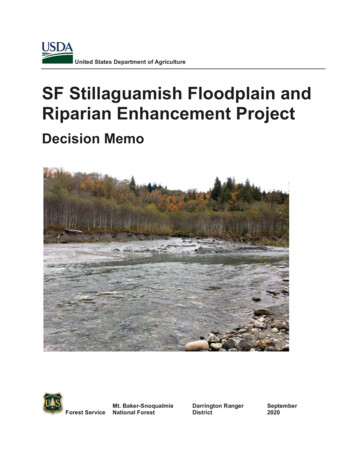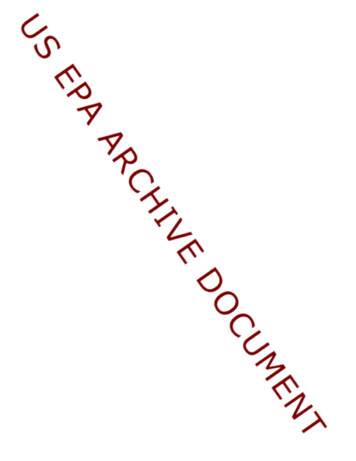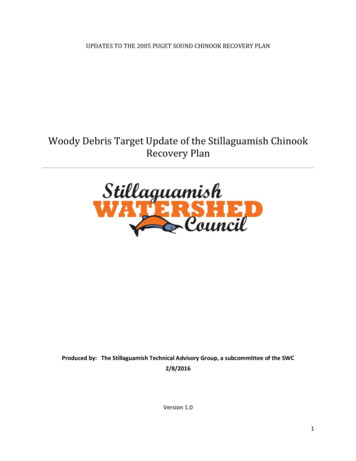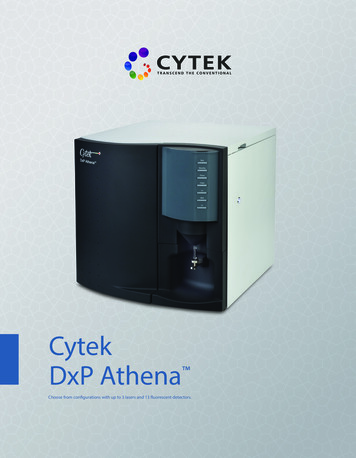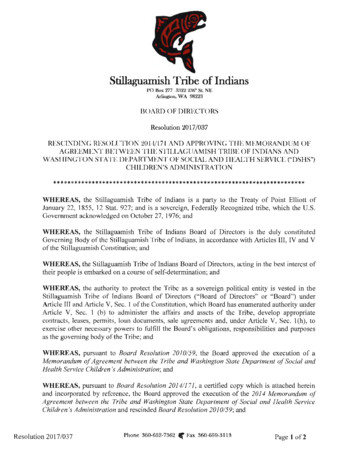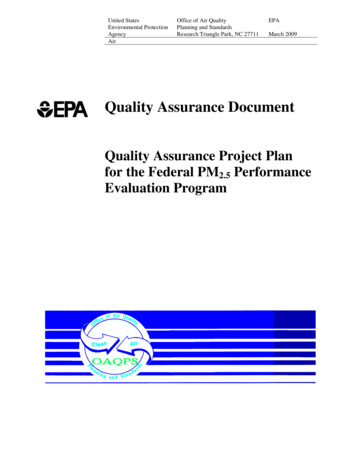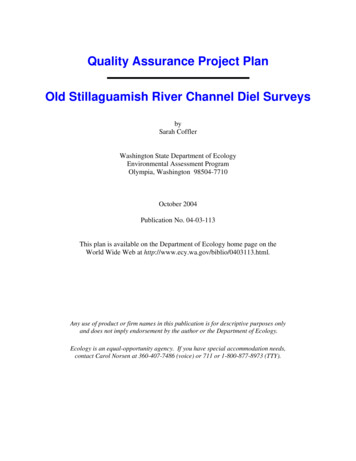
Transcription
Quality Assurance Project PlanOld Stillaguamish River Channel Diel SurveysbySarah CofflerWashington State Department of EcologyEnvironmental Assessment ProgramOlympia, Washington 98504-7710October 2004Publication No. 04-03-113This plan is available on the Department of Ecology home page on theWorld Wide Web at http://www.ecy.wa.gov/biblio/0403113.html.Any use of product or firm names in this publication is for descriptive purposes onlyand does not imply endorsement by the author or the Department of Ecology.Ecology is an equal-opportunity agency. If you have special accommodation needs,contact Carol Norsen at 360-407-7486 (voice) or 711 or 1-800-877-8973 (TTY).
Quality Assurance Project PlanOld Stillaguamish River Channel Diel SurveysOctober 2004Waterbody Number: QE93BW – WA-05-1010User Study ID: SCOF0001ApprovalsApproved by:October 22, 20024Sally Lawrence, NWRODateApproved by:Dave Garland, Unit Supervisor, NWROOctober 21, 20024DateApproved by:Kevin Fitzpatrick, Water Quality Section Manager, NWROOctober 22, 20024DateApproved by:Sarah Coffler, Project Manager, Watershed Ecology SectionOctober 21, 20024DateApproved by:Karol Erickson, Unit Supervisor, Water Quality Studies UnitOctober 25, 20024DateApproved by:Will Kendra, Section Manager, Watershed Ecology SectionOctober 26, 20024DateApproved by:Cliff Kirchmer, Ecology Quality Assurance OfficerOctober 28, 20024DatePage 2
Table of ContentsPageAbstract .4Background .4Introduction.4Water Quality Issues .7Study Objectives .8Project Description.8Project Organization .10Methods and Data Quality Objectives .10Quality Control Procedures.11Project Schedule.11Data Reporting .11References.12Appendix: Stillaguamish Tribe Standard Operating Procedures (SOPs) for the Collection ofDissolved Oxygen, pH, Temperature, and Conductivity Measurements.Page 3
AbstractThe Old Stillaguamish River Channel is one of two channels connecting the Stillaguamish Riverto the Puget Sound in Western Washington State. Low freshwater inflow during the dry seasoncauses the channel to function like a tidal slough. Segments of the Old Stillaguamish RiverChannel were included on the 1998 and Draft 2002/2004 Section 303(d) lists. Two modificationshave recently been made in the Old Stillaguamish River Channel with the potential to affectwater quality, including a reverse tide gate and upgrades to the City of Stanwood WastewaterTreatment Plant (WWTP).The primary objective of the Old Stilliguamish River Channel diel surveys is to provide newwater quality baseline data that reflects any changes the new tide gate may have on water qualityin the channel. The data will help to determine the assimilative capacity of the Old StillaguamishRiver Channel for a future Total Maximum Daily Load (TMDL) study addressing the 303(d)listings.BackgroundIntroductionThe Stillaguamish River runs from the Cascade Range to Port Susan of Central Puget Sound inWestern Washington State (Figure 1). At river mile 2.75, the river splits into the OldStillaguamish River Channel and Hatt Slough (Figure 2). The Old Stillaguamish River Channelwas the primary channel to Port Susan until a series of floods redirected flow to Hatt Slough over70 years ago. Hatt Slough provides a direct pathway to Port Susan; the Old Channel meandersfor eight miles until it splits into the South and West Passes. The South Pass transportsapproximately 80 percent of the flow to and from Port Susan, and the West Pass transports theremaining flow to and from Skagit Bay.Page 4
Figure 1. Overview of the Stillaguamish River Basin.Page 5
Figure 2. Overview of the Old Stillaguamish River Channel.The major source of freshwater to the Old Stillaguamish Channel is the Stillaguamish River.Church Creek, Miller Creek, Jorgenson Slough, Irvine Slough, Douglas Slough, and multipledrainage ditches also discharge into the Old Stillaguamish River Channel (Figure 2). During thedry season, freshwater inflow from the Stillaguamish River, tributaries, and drainage ditches islimited and the Old Channel functions much like a tidal slough. During the wet season, the OldChannel is flushed by increased discharge from the Stillaguamish Basin. Fewer flood events inthe past couple of years have resulted in a build up of sediment and vegetation in the OldChannel.Land surrounding the channel is primarily privately owned and used predominately foragricultural purposes. The city of Stanwood (population est. 3,345) is located north of thechannel and has an active urban growth area (Figure 2). The city operates a wastewater treatmentplant (WWTP) that discharges into the channel. Twin City Foods, Inc. applies food processingwastewater onto land bordering the south end of the channel.Page 6
Water Quality IssuesThe Old Stillaguamish River Channel and associated tributaries provide a passage for fishmigration, habitat for wildlife, sites for secondary contact recreation, and a source of industrialand agricultural water. Federally threatened Puget Sound chinook salmon and bull trout use theOld Stillaguamish River Channel as a migration route.Calculations estimate the flushing rate of the Old Stillaguamish River Channel to be three daysduring the dry season (Glenn, 1996). Poor flushing of contaminants may be contributing to waterquality problems in the channel, especially upstream of the Stanwood WWTP outfall.According to Chapter 173-201A of the Washington State Administrative Code (WAC), the OldStillaguamish River Channel and associated tributaries are designated as Class A waterbodies.Some areas of the Old Channel qualify as Class A marine water because of salinityconcentrations. Classifications are assigned based on general characteristics, characteristic uses,and water quality criteria.In 1998, the Washington State Department of Ecology (Ecology) listed segments of the OldStillaguamish River Channel on the Section 303(d) list of the Federal Clean Water Act as notmeeting water quality standards for fecal coliform bacteria, ammonia, lead, copper, and nickel.The draft 303(d) list for 2002/2004 lists fecal coliform bacteria, temperature, fish habitat,dissolved oxygen, ammonia, and pH as parameters of concern in the Old Stillaguamish RiverChannel.Water quality issues have also been reported in tributaries to the Old Stillaguamish RiverChannel. Jorgenson Slough was included on the 1998 303(d) list for not meeting water qualitystandards for fecal coliform bacteria (Table 1). It was listed again, along with Church Creek,Miller Creek, and Irvine Slough, on the draft 2002/2004 303(d) list (Table 1). Parameters ofconcern, listed on the draft 2002/2004 303(d) list, for tributaries to the Old Stillaguamish Riverinclude fecal coliform, fish passage, fish habitat, instream flow, and dissolved oxygen (Table 1).Table 1. 1998 and Draft 2002/2004 Section 303(d) Listings for the Old Stillaguamish RiverChannel and Associated Tributaries.Water Course #Name1998 303(d) Listings2002/2004 Draft 303(d)Listings1QE93BWOld Stillaguamish RiverChannelFecal Coliform, Ammonia,Copper, Lead, NickelFecal Coliform, Temperature,Fish Habitat, Dissolved OxygenGH05SXChurch CreekGH05SXJorgenson SloughHS19KTIrvine SloughFecal ColiformFecal Coliform,Fish Passage BarrierFecal Coliform, Fish Habitat,Instream FlowFish HabitatFecal Coliform, Fish Habitat,Dissolved Oxygen1Categories 5 (TMDL required), 4 (Impaired but no TMDL required), and 2 (Waters of concern).KX60NOMiller CreekPage 7
In 2004, Ecology completed a Total Maximum Daily Load (TMDL) study analyzing fecalcoliform, dissolved oxygen, pH, mercury, and arsenic water quality violations in the MainstemStillaguamish River and Hatt Slough (Joy, 2004). Ecology plans to carry out a TMDL addressingwater quality issues in the Old Stillaguamish River Channel and associated tributaries in thefuture.Study ObjectivesTwo modifications have recently been made in the Old Stillaguamish River Channel with thepotential to affect water quality. The local Flood Control District began operating a reverse tidegate at the head of the Old Channel during the 2003 low-flow period to enhance freshwaterinflow. In 2004, the city of Stanwood upgraded the WWTP to improve effluent quality andincrease capacity. The facility has requested a National Pollutant Discharge Elimination(NPDES) permit that would authorize continuous year-round discharge.The Stillaguamish Tribe, in cooperation with the Stillaguamish Flood Control District, currentlymonitors several locations in the Old Stillaguamish River Channel on a quarterly basis. The triberecords instantaneous temperature, pH, conductivity, salinity, and dissolved oxygen data andcollects fecal coliform, hardness, alkalinity, and total suspended solids grab samples.Continuous monitoring data of parameters with strong diel changes are needed during criticalseasonal events so diel minimums and/or maximums can be observed. The primary objective ofthe Old Stillaguamish River Channel diel surveys is to provide new baseline data that reflectsany changes the new tide gate may have on water quality in the channel. The data will help todetermine the assimilative capacity of the Old Stillaguamish River Channel when the TMDLevaluation is conducted.Project DescriptionTwo diel surveys will be conducted in the Old Stillaguamish River Channel during the 2004 lowflow period (July-September). Diel surveys will be scheduled to coincide with diurnal surveys ofthe channel performed by the Stillaguamish Tribe. During each diel survey, multi-probe dataloggers will be deployed at three sites in the channel to log temperature, pH, dissolved oxygen,and salinity data every 30 minutes for 48 hours. Sites will be located along the upper end of thechannel between the new tide gate and the Stanwood WWTP (Figure 3). Diel monitoring sitesare listed in Table 2.Page 8
Table 2. Potential Monitoring Sites for the Old Stillaguamish River Channel Diel Surveys.EcologyStillaguamishStation IDTribe Station IDOSRC1Station DescriptionLatitudeLongitude090Old Stillaguamish River Channel at Norman Rd. bridge48.2132 N-122.3268 WOSRC2145Old Stillaguamish River Channel off Florence Rd.48.2213 N-122.3310 WOSRC3165Old Stillaguamish River Channel at Marine Dr. bridge48.2257 N-122.3382 WOSRC4066Old Stillaguamish River Channel at private dock off Leque Rd.48.2360 N-122.3650 WFigure 3. Potential Monitoring Sites for the Old Stillaguamish River Channel Diel Surveys.Page 9
Project OrganizationThe diel surveys will be conducted as a joint effort between Ecology and the StillaguamishTribe. Ecology will supply, calibrate, deploy, and pick-up the data loggers in addition toperforming Winkler titrations of dissolved oxygen samples. The Stillaguamish Tribe will supplyand calibrate field meters, collect instantaneous field data measurements, and perform mid-cyclechecks of the data loggers. Ecology will prepare a Quality Assurance (QA) Project Plan and datasummary of the diel survey results.Methods and Data Quality ObjectivesField measurements, methods, and associated data quality objectives are outlined in Table 3.Ecology personnel will follow Watershed Assessment Section protocols when using the multiprobe data loggers and performing Azide-modified Winkler titrations (Ecology, 1993).Stillaguamish Tribe personnel will follow protocols set forth in their own standard operatingprocedures (SOPs) when operating their field meters. Stillaguamish Tribe SOPs for collectingdissolved oxygen, pH, temperature, and conductivity measurements are presented in theAppendix. An SOP for salinity measurements has not yet been written. The tribe currently usesconductivity readings to determine salinity using the Electrical Conductivity Method (APHA,1998).Table 3. Field Measurements, Methods, and Associated Data Quality Objectives Employed inthe Old Stillaguamish River Diel Surveys.AnalysisDissolved OxygenpHSalinity12MethodPrecisionData logger/ field meterAzide-modified WinklerData logger/ field meterData logger/ field meterSpecific ConductivityData logger/ field meterTemperatureData logger/ field meter1Bias% Deviationfrom True ValueRequired ReportingLimitsConcentration UnitsNA0.6 mg/L0.1 mg/L to 15 mg/L0.2 mg/LNA0.1 mg/L to 15 mg/L0.05 s.u.0.10 s.u.1 to 14 s.u.250.1 ppt251 umhos/cm0.05 C1 C to 40 C 10% RSD 10% RSD0.025 CEcology, 1993Relative Standard DeviationPage 10
Quality Control ProceduresData loggers and field meters will be calibrated according to manufacturer instructions.Calibration data will be used to evaluate field measurement accuracy. Field meters will be usedto monitor data logger performance at deployment, mid-cycle ( 24 hours), and pick-up.Dissolved oxygen samples for Winkler titration will be used to monitor the performance of fieldmeter and data logger dissolved oxygen probes. Field replicates of dissolved oxygen sampleswill be collected at a frequency of at least 10 percent to evaluate sampling precision. Field meterdata may be adjusted for bias based on Winkler titration data.Project ScheduleProject TaskExpected Date of CompletionDiel SurveysData Quality AssuranceEIM Data EntryData Transmittal MemoTwo 48-hour surveys; July through September 2004November 2004December 2004December 2004Data ReportingData collected during the Old Stillaguamish River Channel diel surveys will be reviewed forquality assurance, entered into Ecology’s Environmental Information Management (EIM)system, and presented in a technical memo to NWRO and the tribe. The primary objective of thediel surveys is to provide updated background data. As a result, a report analyzing the data is notscheduled.Page 11
ReferencesAPHA, et al., 1998. Standard Methods for the Examination of Water and Wastewater.Twentieth Edition. American Public Health Association, American Water Works Association,and Water Pollution Control Federation. Washington D.C.Ecology, 1993. Field Sampling and Measurement Protocols for the Watershed AssessmentsSection. Publication No. 93-e04. Environmental Assessment Program, Washington StateDepartment of Ecology, Olympia, WA. http://www.ecy.wa.gov/biblio/93e04.html.Glenn, N., 1996. An Analysis of the Effect of Discharged Wastewater on the Stillaguamish Riverat Stanwood. Publication No. 96-330. Washington State Department of Ecology, Olympia, WA.Joy, J., 2004. Stillaguamish River Watershed Fecal Coliform, Dissolved Oxygen, pH, Mercury,and Arsenic Total Maximum Daily Load Study. Publication No. 04-03-017. Washington StateDepartment of Ecology, Olympia, WA. http://www.ecy.wa.gov/biblio/0403017.html.Page 12
AppendixStillaguamish TribeStandard Operating Procedures (SOPs)for Collecting Dissolved Oxygen, pH, Temperature,and Conductivity MeasurementsPage 13
SOP-STILL-FM-1 – Dissolved OxygenSTANDARD OPERATING PROCEDURESJanuary 10, 2003 – Revision 1. 4 pagesTitle:Dissolved Oxygen, Routine measurements: Membrane ElectrodePurpose:To obtain accurate and precise measurements of dissolved oxygen in water andwastewater.Summary:This procedure describes the methods and calibration of a dissolved oxygen meterand probe for the determination of dissolved oxygen in water and wastewater.Dissolved oxygen meters are used routinely in standardized laboratory and fieldmonitoring regimesThe attached Standard Operating Procedure was prepared by:Name and TitleSignature and Date SignedThe attached Standard Operating Procedure was reviewed by:Name and TitleSignature and Date SignedFollow only the most recent issue of this SOPPage 14
Dissolved Oxygen Measurements: Membrane ElectrodeMethodology:Method: EPA 360.1EPA-600 / 4-79-020 Methods of Chemical Analysis of Water and Wastes.EPA Office of Research and Development, Cincinnati, Ohio 45268(March 1979)YSI Model 51-B Operators ManualYSI Model 85 Operators ManualEQUIPMENTCalibration and Use:Instrument probes used for determining dissolved oxygen are dependent upon electrochemicalreactions. Steady state conditions are necessary for proper and accurate readings. This requires theprobe to be in thermal equilibrium with the solution or calibration media.1)Before calibrating, allow probe to come to temperature equilibration with the media being measured.This could be in any body of water, stream or laboratory setting. Equilibrium is reached in about 1 min.2) For field calibrations we will use the air calibration method. Refer to manufactures instruction manualattached to this SOP for precise procedures.3) Compare air saturation readings with the values listed on the back of the DO meter or in the Tablesfor solubility of oxygen exposed to water saturated air. Also, refer to correction tables for highaltitudes and low barometric pressure. In estuaries or marine waters it will be necessary to know thesalinity of the water. Use the S-C-T Meter for salinity observations.4) If readings are erratic or unreasonable it may be necessary to do one of the following checks:* Check battery condition. Replace if necessary.* Inspect rubber seals on the probe and calibration chamber for proper fit. Water must beexcluded from the chamber.* Ensure that the end of the calibration chamber is open to atmospheric pressure.* Check and replace the membrane on the DO probe if damaged or oiled.See manufactures use and operations manual attached to this SOP.5) Record DO readings on the data sheet. Be sure to take water temperature so % DO saturation can becalculated. In estuaries or marine waters record the salinity.6) Leave the instrument ON between measurements to avoid the necessity to repolarize the probe.7) Obtain duplicate readings at appropriate locations to satisfy QA/QC Protocols.8) Store membrane electrode between analyses and when not in use in the airtight plastic bottle withmoistened sponge.9) Refer to SOP-STILL-QC-1; In-house Data Checks for mathematical computations and statisticalevaluations.10) All maintenance is to be recorded in the bound lab notebook. Examples of maintenance are; DOmembrane replacement, new batteries, electrode cleaning, cable replacement and factory service.Follow only the most recent issue of this SOPPage 15
DISSOLVED OXYGEN METER CALIBRATION AND USEPROCEDUREThe procedures for preparing the oxygen probe, and the calibration procedures for using theoxygen meter are somewhat detailed. Rather than rewriting the guides, the manufacture'sinstruction and operation manuals for the dissolved oxygen meter and probe are attached to thisSOP.Calibration of the meter should be conducted prior to each day’s use. The results of thecalibration will be noted. If calibration is not attainable then the troubleshooting guide is to befollowed to solve the problem.All maintenance is to be recorded in the bound lab notebook. Examples are; DO membranereplacement, new batteries, cleaning, and other pertinent information. Copies of this informationshould be placed into the Dissolved Oxygen notebook in the lab.Follow only the most recent issue of this SOPPage 16
SOP-STILL-FM-1STANDARD OPERATING PROCEDURESTitle:Dissolved Oxygen, Routine measurements: Membrane ElectrodeThis SOP is a guide for conducting and understanding dissolved oxygen measurements infreshwater, wastewater and marine environment. It is also to ensure that the best possible data isgenerated from field collection activities and laboratory analyses. From time to time, this SOPwill be reviewed by staff for QA/QC purposes.The attached Standard Operating Procedure for pH measurements was reviewed by:Name and TitleSignature and Date SignedFollow only the most recent issue of this SOPPage 17
SOP-STILL-FM-2 - pHSTANDARD OPERATING PROCEDURESJanuary 10, 2003 – Revision 1. 5 pagesTitle:pH; Routine measurements for surface waters; Electrometric MeasurementPurpose:To obtain accurate and precise measurements of pH in water and wastewater.Summary:This procedure describes the methods and calibration of a pH meter andassociated electrodes. pH meters are used routinely in standardized laboratory andfield monitoring programs. pH measurements will always be taken within the top10 cm. of aqueous solutions and follow operations as recommended by themanufacturer.The attached Standard Operating Procedure was prepared by:Name and TitleSignature and Date SignedThe attached Standard Operating Procedure was reviewed by:Name and TitleSignature and Date SignedFollow only the most recent issue of this SOPPage 18
pH: Calibration and routine measurements for surface waters;Electrometric MeasurementMethodology:****Method: EPA 150.1EPA-600 / 4-79-020 Methods of Chemical Analysis of Water and Wastes.EPA Office of Research and Development, Cincinnati, Ohio 45268(March 1979)Orion 720-A Operators ManualOrion 250-A Operators ManualWater Quality: Basic Principles and Experimental Methods; J RichardMayer,Huxley College of Environmental Studies. Western WashingtonUniversity; Bellingham, WA. 1995 pp. 45-60EQUIPMENTCalibration and use:*********Combination glass pH electrode (recommend Orion 8102-BNC )pH meterDistilled or deionized waterWash bottlepH buffer solutions (4,6,7,8, and 10)Kimwipes or equivalentElectrode filling solutionsElectrode storage solutions; saturated KCLRing stand or supportPROCEDURECalibration and Use:The procedures for determining pH values require special attention be given to the monitoringsystems as a whole if valid data is to be obtained. Steady state conditions are necessary forproper and accurate readings. In-situ measurements are strongly desired. This requires the pHprobe to be in thermal equilibrium with the solution or calibration media even though the probeand meter are temperature compensated.When conducting field measurements, pH calibration results are entered on the field data sheetsalong with the time calibration occurred. Laboratory calibration checks are recorded and kept inthe pH meter maintenance logbook. Serial numbers of pH probes are recorded on data sheets.Follow only the most recent issue of this SOPPage 19
pH Calibration taff members shall read and be familiar with the operations manual provided bythe manufacturerNew glass electrodes and those stored dry shall be conditioned and maintained asrecommended by the manufacturer.Before calibrating , allow pH probe and calibration standards to come totemperature equilibration with the media being measured. This could beaccomplished by securing probe and standards to a support stand, placed in anybody of water, stream or laboratory setting. Ten minutes is probably sufficient forfield measurements.Use of a meter with temperature compensation is preferable. If manualtemperature compensation is to be used, adjust temperature according tomanufacturers recommendations.Choose two pH calibration buffers that will bracket your expected sample range.(i.e. pH 7 and either pH 4 or pH 10).Immerse the electrode into the first reference buffer solution. Wait for a stable pHdisplay. Determine the correct pH value by first reading the temperature of the pHbuffer and then by using the pH buffer label, ascertain the correct pH valueassigned for that temperature. Set the known pH of the reference buffer solutionin accordance with the manufactures instructions.Record this reading on the data sheet in the proper location. Also include the timeThe calibration was performed.Rinse the electrode with distilled water. Blot gently and place into the secondbuffer solution. Wait for stable pH display. Determine the correct value as in step6 above. Record this reading as in step 7 above.Recheck the pH 7 buffer. Readings should be within 0.01units of the originalsetting. If readings are more than 0.05 units above or below the buffer value,recalibrate (steps 5 through 10).For environmental sampling, record the values of buffers, pH 6, pH 7 and pH 8.Rinse and blot electrode between measurements. They will be used ascalibration checks during subsequent monitoring.If erratic readings continue, consult the manufactures operating instructions.Follow only the most recent issue of this SOPPage 20
pH Routine MeasurementsUse:1)2)3)4)7)8)7)8)10)After calibration has been completed, rinse the electrode with distilled water andblot dry.For stream monitoring, set a support stand into the water and secure the pH probefor the duration of the measurements. Care must be taken to avoid submerging theprobe or getting the meter wet.Gently place the electrode into the solution being measured.Rotate the pH probe, in its holder, so that the frit is facing downstream. AvoidSTREAMING conditions. (see manufactures operations manual) In rare cases asubsample of water may have to be tested.When pH reading stabilizes, record to the nearest 0.05 unit. Also record thetemperature to the nearest 0.1º C.Leave the meter ON so that the calibration sequence doesn’t have to be performedAt each station. Simply measure and record the pH 6, pH 7, and pH 8 buffers ateach station. If values for these buffers differ significantly from the initialcalibrations, then recalibration will be necessary.Insert the moistened protective sleeve over the pH probe during transport betweensampling sites. Distilled or tap water is sufficient. Do not let the probe dry out.When left overnight, the electrode should be placed into the electrode storagesolution (saturated KCL).All maintenance to the pH system is to be recorded in the laboratory notebook.Examples of maintenance are; new batteries, electrode cleaning, buffer solutionreplacement and factory service.Follow only the most recent issue of this SOPPage 21
SOP-STILL-FM-2STANDARD OPERATING PROCEDURESTitle:pH; Routine measurements for surface waters; Electrometric MeasurementThis SOP is a guide for conducting and understanding pH measurements. It is also to ensure thatthe best possible data is generated from field collection activities and laboratory analyses. Fromtime to time, this SOP will be reviewed by staff for QA/QC purposes.The attached Standard Operating Procedure for pH measurements was reviewed by:Name and TitleSignature and Date SignedFollow only the most recent issue of this SOPPage 22
SOP-STILL-FM-3 - TemperatureSTANDARD OPERATING PROCEDURESJanuary 10, 2003 – Revision 1. 5 pagesTitle:Temperature; Routine measurements for surface waters: ThermometricPurpose:To obtain accurate and precise measurements of temperature in water andwastewater.Summary:This procedure describes the methods for use and calibration of thermometers.Thermometers are used routinely in standardized laboratory and field monitoringprograms for measuring temperature in water, air and other media. Thermometersare calibrated in the laboratory against a NIST certified thermometer prior to fieldsampling.Temperature recording devices such as thermographs are calibrated beforedeployment and after recovery.The attached Standard Operating Procedure was prepared by:Name and TitleSignature and Date SignedThe attached Standard Operating Procedure was reviewed by:Name and TitleSignature and Date SignedFollow only the most recent issue of this SOPPage 23
Temperature: Calibration and routine measurementsMethodology:**Method: EPA 170.1EPA-600 / 4-79-020 Methods of Chemical Analysis of Water and Wastes.EPA Office of Research and Development, Cincinnati, Ohio 45268(March 1979)Water Quality: Basic Principles and Experimental Methods;J Richard Mayer,Huxley College of Environmental Studies. Western WashingtonUniversity; Bellingham, WA. 1995 pp. 45-60EQUIPMENTCalibration and use:Note:If a certified NIST precision thermometer is used, then no additional calibrationsare necessary. For non-certified thermometers, calibrations must be conducted.* Certified NIST precision thermometer (for reference)* Mercury-filled glass thermometer reading in 0.1 degrees centigrade (º C.)* Water bath* Hot plate* Ice* Rock sale (optional)* Magnetic stir plate and stir bars.* YSI Model 85; Operations ManualPROCEDURECalibration and Use:A temperature calibration at three points is recommended. Low, mid-range and high. Steady stateconditions are necessary for proper and accurate readings. This requires the thermometers to bein thermal equilibrium with the water bath. Laboratory calibration records are kept in thethermometer maintenance log book. Serial numbers of thermometers are recorded on data sheets.Follow only the most recent issue of this SOPPage 24
Temperature MeasurementsCalibration:1)2)3)4)5)6)Place a certified thermometer along with the other non-certified laboratorythermometers into a water bath at the temperature to be monitored.If the water bath is placed on a magnetic stirrer, then stir bars can circulate thewater and maintain a steadier water temperature. An insulated water bath may benecessary when calibrating thermographs at specific temperatures.Rock salt and shaved ice can be used to achieve temperatur
OSRC3 165 Old Stillaguamish River Channel at Marine Dr. bridge 48.2257 N -122.3382 W OSRC4 066 Old Stillaguamish River Channel at private dock off Leque Rd. 48.2360 N -122.3650 W Figure 3. Potential Monitoring Sites for the Old Stillaguamish River Channel Diel Surveys.
